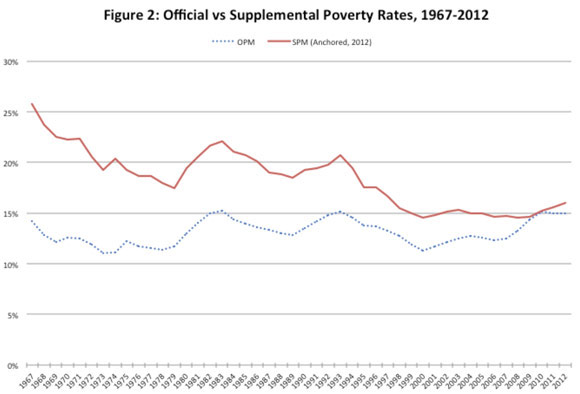The growing consensus is that the war on poverty has not failed once you use more appropriate measures, according to John Cassidy in the New Yorker. To see the article: Click Here.
He shows a chart using the official poverty measure. The official poverty measure was created in 1963 based on a multiple of a thrifty meal plan. It has long been regarded as an inaccurate measure in terms of actually measuring what people need to meet basic costs of living (technical term: it lacks content validity). However, it has the benefit of being reliable because it is the same measure merely adjusted for inflation, so it is an apples-to-apples comparison.
Other measures have been proposed, and he shows how the data looks using a revised measure created by the Census Bureau and used by researchers to do a more accurate analysis. Cassidy writes about the solid red line: “It represents the Columbia researchers’ estimate of historical poverty rates according to a new and more comprehensive measure of need that the Census Bureau created in 2011, known as the supplemental poverty measure (S.P.M.). According to this revised metric, the poverty rate in 1967 was as high as twenty-six per cent. It has since fallen dramatically, to sixteen per cent in 2012; in the period immediately before the Great Recession, it fell below fifteen per cent.”
Any measure needs to be assessed: what was included, how was it measured, and how well does it really measure what it states it is measuring. I have not looked at it yet–stay tuned.
It is also true from a research perspective, however, that we do not know what the poverty rates would have looked like if there were no program in effect over the past 50 years. Nor do these measures tell us about how many of the negative impacts of poverty have been averted: poor nutrition leading to health problems and child mortality, lack of access to education that opens the door to the American dream, and of course, the impact on crime. It should be noted that despite the massive economic collapse and the almost 20 years of a flat-lined median household income, the crime rate has not really changed. If people have food and enough to get by, they apparently do not opt for robbing their neighbors.
Politics, however, is often more about “position” than facts. Congressman Paul Ryan talks about anti-poverty policy failure and argues against “dumping money into programs we know don’t work.” His statement should be seen for what it is: an ideological position that is nothing more than an opinion masquerading as fact. It is a form of deception.
It is also important to recognize that the anti-poverty programs were not designed to revive an economy that has a weak heartbeat. Poverty, no matter how it is measured, will increase during economic downturns; no programs should be blamed for a failing economy. If the private sector is unable or unwilling to provide sufficient jobs at a living wage to all those who want to work, then perhaps the government should create public works jobs, taking a page from the FDR strategy. Requiring that all wages for full-time employment be above the poverty level–substantially above, so that people are paid a living wage that is appropriate to meet the basics for food, housing, transportation, health insurance, child care for the area in which they live. More radically–if you want to consider President Nixon a radical–we could implement his proposal for a guaranteed annual income for everyone; if I were queen, I would set this at the poverty level, but at the very least, it should be set at the lowest level of social security benefits. Why not boost many children of this country out of poverty as we did for the elderly?
